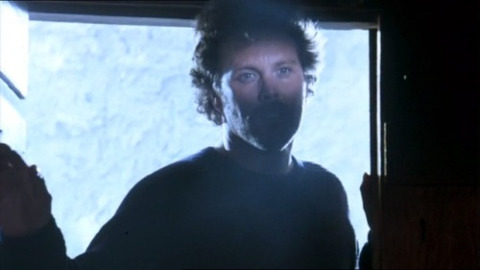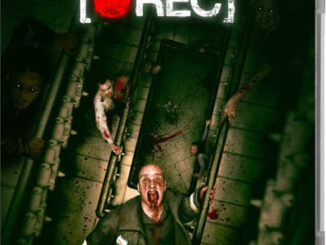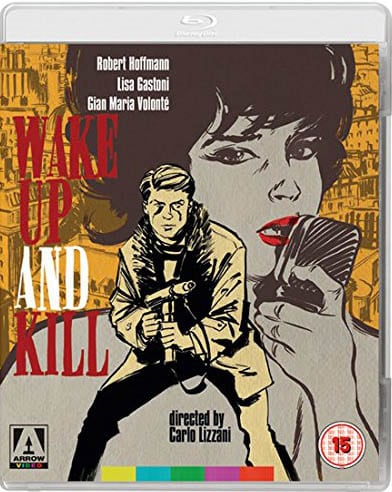The Wind (1986)
Directed by: Nico Mastorakis
Written by: Fred Perry, Nico Mastorakis
Starring: David McCallum, Meg Foster, Robert Morley, Wings Hauser
AKA THE EDGE OF TERROR
USA
ON BLU-RAY from ARROW VIDEO
RUNNING TIME: 92 mins
REVIEWED BY: Dr Lenera

Sian Anderson is a mystery novelist who leaves her posh Los Angeles home and her husband John to write her next thriller on a small island in Greece named Monemvasia. She rents her villa from the elderly, verbose Englishman Elias Appleby, who warns her about the violent and tempestuous “Wind” that can attack at night, and also meets her somewhat unbalanced American expatriate neighbour Phil. That night Elias fires Phil, who responds by murdering Elias. Sian later looks out of a window and sees Phil digging up dirt, then finds Elias’s body. This makes her a target for Phil who just won’t give up….

The name The Wind perhaps suggests that this film will be like The Fog in which the title phenomena has supernatural origins. At the very least, it make us expect it to be a major element in the story. Not far in, we and our heroine are enticingly told that, “The wind can be very dangerous at this time of year, it can be strong enough to kill a young bullock or gentle enough to caress a beautiful young lady”, but little really comes of this except for us continually hearing it outside and shutters being banged about. It’s not even as if it’s really preventing Sian from leaving the house in which she’s supposedly trapped by a psychopath, because there are times when she goes outside to do something with not nearly as much hassle as we’d think. But then this a film with a lot of strange behaviour, not to mention a house that seems to get progressively bigger the more we are inside it. It’s another offering from straight-to-video veteran [though this one made it to cinemas in West Germany and Portugal] Niko Mastorakis, still best known for his debut Island Of Death which made the Video Nasty list in the UK. Indeed it would be a nasty piece of work if it was better made. Every now and again Arrow Video release one of his films and probably give it better treatment than they deserve, though Hired To Kill and The Zero Boys both provided some entertainment for Yours Truly, so he was willing to see what The Wind, a film whose artwork proved so pleasing to its distributors in Turkey video that it was re-used it for a Friday the 13th Part V: A New Beginning poster, slightly altered to include a blue-cheeked hockey mask, would offer.
What we have here is Mastorakis’s entry in the ‘lone female in house menaced by a bad guy or bad guys’ sub-genre typified by the likes of Wait Until Dark, Fright and When A Stranger Calls, with Hush being a pretty good recent example. It’s an almost surefire way to get viewers on edge and hard to really cock up, so I got quite excited when I realised that The Wind was going to largely consist of a man trying to repeatedly get at a woman who saw him do something very suspicious, and I liked the confidence of Mastorakis and his co-writer Fred Perry in the way that they let us know who the menace was going to be in the character’s very first scene before he’s even done anything bad. Unfortunately the result just mostly shows the limitations of Mastorakis as a film-maker, the man somewhat overreaching, proving rather out of his depth in trying to create a thriller centered around a single situation, and attempting a more stylish approach than normal. Two very strong lead performances ensure that things never get too painful, and the setting is a little different and exploited well when things are taking place outside. One could possibly see it as a sort of continuation of Island Of Death where, instead of people from outside abusing the locals, the former are mostly causing trouble among themselves. But how seriously can you take a film which botches, for example, what should have been a good scare when one character is talking and goes to stand with his back to a window? It’s so obviously a set-up, but might still have worked if we hadn’t seen the stationery shadow of something protruding from the right hand edge of the window, and if we’d then got more than a cut to the victim just stumbling about with a sickle in his back.
The beginning scene of an old lady’s voice telling a story of a dead man begging Jesus to be let through the gates of Heaven while the camera explores the interior of a house creates some atmosphere. The tale is actually being told by novelist Sian to her husband John, and finishes with an apparent joke that I failed to get – or maybe I’m just having a ‘slow’ day. John is played by David McCallum who was clearly just in it for the paycheck. We get a suggestion that their marriage isn’t doing it for Sian sexually, and that she’s not just off to Greece to write next murder mystery in seclusion. “I want to play,” says she to one of her friends, who replies, “You’ll play, even if you have to do it with a ghost”. With mates who utter dialogue like that, it’s tempting to think that Sian will be far better off on this Greek island, a place that was once a fortress but is now largely deserted – well, Elias tells her that the people like to go to the markets but we see hardly any people and certainly no market. Elias, the owner of the house she’s renting, is in the shape of Robert Morley, and it’s funny to see him in a film like this, but unlike McCallum he puts in some effort despite his age, delivering lines such as, “the great thing about Greek women is that they never complain” with some enthusiasm. Despite his sexist, even slightly racist, attitudes, I wished that he’d been in the film more. He’s soon killed by Phil, but as worthy of note are Phil’s first appearances to Sian. She sees him looking at her from a distance, then running away laughing after leaving shopping at her door and knocking, then suddenly appearing in her larder which you can get into from outside. Now you’d think that the latter in particular would be intimidating for Sian, but she doesn’t seem bothered even though she surely notices that Elias isn’t ‘all there’ – it’s obvious. That night, her typing is inter-cut with Phil murdering Elias while Sian’s voice-over tells us of a character in her story being slain the same way. It’s one of Mastorakis’s more successful montages, though it suggests a Tenebrae/Basic Instinct-like element of real murder paralleling fictional murder which is never referred to again.

For a while Sian still reacts as if things aren’t that bad. John, who remember is supposed to be her husband, doesn’t seem too bothered either. She rings him, and later rings him again where he tells her that he’s put two men on the case, but not sounding concerned at all. It’s very odd. At least Sian also manages to get in touch with Elias’ Greek wife and the island’s policeman, causing Kesner, a stranded sailor, to go to investigate the call as a favor to the constable, but Phil is good at hiding evidence. Seeing as Kesner is played by Steve Railsback, you’d expect him to start having a go at Sian for making a load of stuff up, but this potential source of conflict is virtually thrown away, while Railsback is strangely restrained. Wouldn’t it have been exciting if Sian saw Kesner as a threat as well? In fact there are several ways in which things could have been made more exciting, Mastorakis clearly struggling with keeping the tension high as phone lines are cut, electricity flickers and nobody in any nearby houses notices or hears somebody repeatedly trying go get in. The middle section suffers from some awkward cutting between inside and outside, where it looks as if some planned shots hadn’t been completed or the material was just assembled really quickly, though it’s probably more down to Mastorakis trying to be more stylised in his approach, probably looking to gialli for inspiration, in part perhaps to make up the low level of onscreen violence [in terms of sickle slashers Mountaintop Motel Massacre this ain’t]. Or maybe this was a failed try at getting people to take him more seriously as a film-maker? The slow motion employed during a big chase works rather well though, though, as well as showcasing the locale.
Indeed Monemvasia, introduced in a very lengthy helicopter shot that shows the beauty of the place, is a nice setting and, despite us seeing very few locals, we see just enough of it to get a sense of where Sian is. The external night-time footage has a genuine Gothic feel, with the narrow passageways, occasional lighting and lots of fog being put to good use – cinematographer Andreas Bellis does a good job here. But so much of the footage inside the villa is either unsatisfying or just plain confusing. At times it’s hard to tell where the two principals are in relation to each other, new doors seem to magically appear, and Phil is curiously incompetent despite it often looking like he could easily kill his quarry. Potentially scary moments involving the two either fail to materialise or are curiously muted. It’s a shame because Meg Foster and Wings Hauser are both good and interact with each other well. Foster, with those mesmerising cat-like eyes of hers at full power, projects the appropriate resilience, though she’s sometimes given supposedly witty remarks that just sound false. In fact Foster’s saddled with quite a few clunkers. “I’m fun to be with” she says to Kesner in an attempt to get him to stay. Is that really what a woman who’s being terrorised by a maniac would say at this time? It’s possible that her sometimes rather relaxed attitude to what’s going on is intended to be down to her experience as a thriller writer, but the premise of somebody suddenly living a story that he or she could have written is never properly followed through. Phil scattering Sian’s manuscripts while saying how poor her stuff is, is about as interesting as it gets. At least Hauser, sporting a rare moustache, is slightly luckier with the lines he’s been given, probably helped of course by his character being insane. He was always good at being menacing while making it look very natural, and ably achieves this again here. Foster and Hauser should have played antagonists again in something better.
Of interest to some will be the musical score partly written by Hans Zimmer. Some passages greatly resemble John Carpenter, Harry Manfredini and Simon Boswell, though it’s mostly unremarkable synth horror stuff typical of the period. His co-composer Stanley Myers probably wrote the two Greek-flavoured pieces heard early on plus some more poppy stuff heard on the radio. The Wind overall just doesn’t function anywhere as well as it should, and you will have seen it all before and done much better, even if it stops short of becoming truly rubbish. I still commend Arrow’s commitment to releasing the work of film-makers such as Mastorakis, and you never know, maybe the next one [Blood Tide] will be better. And maybe that wind played a greater part than it seemed at the time, seeing as I can still hear it ringing through my ears and it just won’t go away….
SPECIAL EDITION CONTENTS
*New restoration by Arrow Films from a 4K scan of the original negative, approved by writer-director Nico Mastorakis
*High Definition (1080p) Blu-ray™ presentation
*Optional English subtitles for the deaf and hard of hearing
*Optional Greek subtitles
*Original DTS-HD Master Audio 5.1 surround and LPCM Stereo 2.0 Audio
*Blowing The Wind – Brand new interview with Director Nico Mastorakis
*The Sound of The Wind – The complete soundtrack composed by Hans Zimmer and Stanley Myers
*A collection of trailers for the films of Nico Mastorakis
*Reversible sleeve featuring original and newly commissioned artwork by Graham Humphreys
FIRST PRESSING ONLY: Illustrated collectors’ booklet featuring new writing on the film by critic and author Kat Ellinger








Be the first to comment